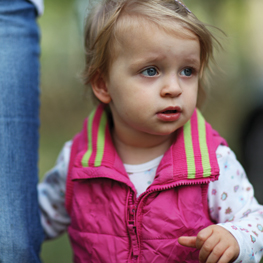“Don’t leave me! No! Please! Mommy! Mommy, don’t go!” Sound familiar?
 Separation anxiety is a normal part of child development. Babies and toddlers will often scream when it is time for mommy or daddy to hand them off to the caregiver - even if it is a familiar routine. It is also normal for preschoolers or young school-age children to become tearful or clingy when starting a new school or returning after a break.
Separation anxiety is a normal part of child development. Babies and toddlers will often scream when it is time for mommy or daddy to hand them off to the caregiver - even if it is a familiar routine. It is also normal for preschoolers or young school-age children to become tearful or clingy when starting a new school or returning after a break.
Seeing their child so upset often results in a very guilty and stressed out parent. Many parents make the separation even more upsetting to their child without realizing it. I have worked with young children and families for over 20 years and have witnessed thousands (maybe millions!) of drop-offs.
Here are some tips for making drop-off less stressful for everyone:
Build familiarity. Bring your child to the facility before their first day. Let them see the caregivers or teachers, other children, play areas and materials. Arrange for them to visit several times, if possible, with the duration increasing slightly with each visit.
Tell your child what to expect. Read storybooks about children who go to a babysitter, daycare or school. Let your child know where you’ll be while you’re away and when you’ll be back. Make sure they know who will be looking after them.
Walk them through the day. For example, “After I walk you to your classroom, I am going to go to work. I packed you ham and cheese for lunch today! After naptime, you’ll go on the playground, and I’ll be back to pick you up at 3 o’clock.”
Don’t sneak out. I’ve seen many parents wait until their child looks away and then rush out the door without a goodbye. When the child realizes this, they often become even more upset than they were originally and it takes longer to calm them down. Let your child know you’re leaving instead of sneaking away.
Be quick. Don’t prolong the goodbye. This doesn’t mean you should push them out of the car and drive off either! Establish a routine, such as you leave after you help your child hang up their backpack. Then give them a cheerful hug, kiss and goodbye and head out.
Keep going. Say goodbye and then go. Tara, a mom of three, says, “I was a mess when I first sent my oldest child to daycare. I would listen outside the door and if she was still crying after 30 seconds, I headed right back in to comfort her. We’d do this half a dozen times or more some mornings. After several months, the director urged me to wait longer. She stood with me and urged me to be patient. My daughter screamed for three minutes and stopped. I continued listening at the door and the crying decreased to mere seconds - if she cried at all!”
Call to check in. If you’re worried, call or email the caregiver, director or teacher to check on your child.
Return on time. When you come back when you say you will, your child will begin to understand that you’ll always return to them. If you’re going to be late, call the facility and emphasize that the message be explained to your child.
Stay calm. Your child senses when you’re upset. If you are feeling guilty, frustrated or sad, they will feed off of your emotions. Stay calm and upbeat at both drop-off and pick-up times.
Rinse and repeat. Stay consistent. Routines help children feel safe. Try to stick to the same schedule every morning.
Be patient. Don’t throw in the towel if your child is still crying after a week. If you are happy with everything else about the caregiver or school, give it some time. It can take several weeks for a child to adjust to a new situation.
However, trust your instincts. If your child’s reluctance to part from you is very out of character, there could be a situation with the caregiver, teacher or environment causing them stress.
Remember that like most childhood phases, this too shall pass.
However, if drop-off causes your child intense and prolonged emotional distress, they may be suffering from separation anxiety disorder. According to www.kidshealth.org, separation anxiety disorder is rare, but can last into elementary school and beyond. Characteristics include a reluctance to sleep alone, loss of appetite, nightmares and panic attacks. If your child is excessively fearful of being separated from you, talk to your pediatrician.
Rachael is a mom, freelance writer, educator and family advocate. For more information, visit www.rachaelmoshman.com.
Calgary’s Child Magazine © 2024 Calgary’s Child